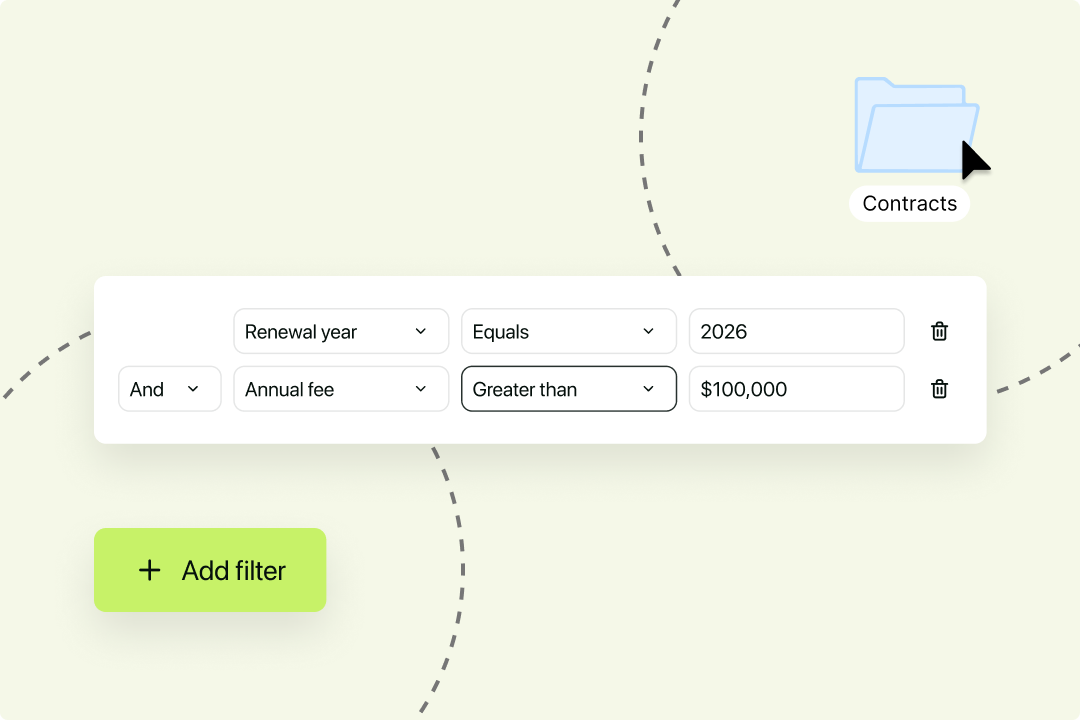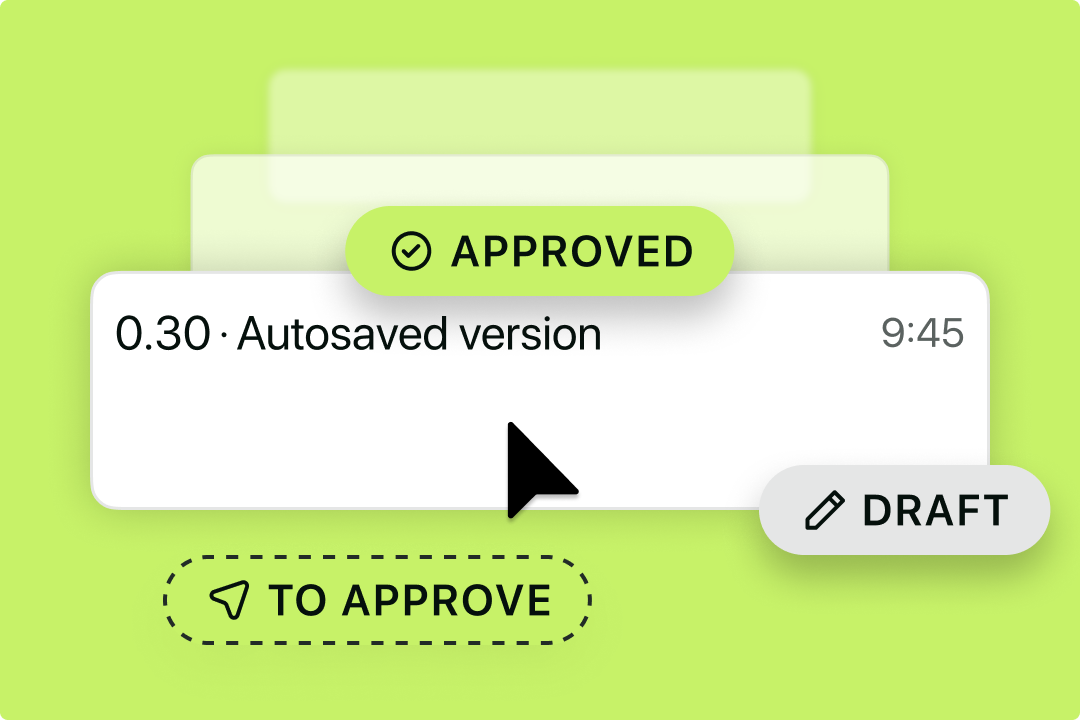Solutions
Customer Support
Resources
Organizing contracts can be a tough job, particularly for scaling businesses with growing contract volumes. This post shares best practices that can make it that bit easier.
Contract organization is the process of saving, sorting and filing contracts to make them easier to find when you need them. It typically involves making decisions about:
According to the WCC, poor contract management can cost a business as much as 9 per centof its annual revenue. Not organizing your contracts effectively plays a big part in this.
If you don’t know where your contracts are, how can you track upcoming renewal deadlines, or the contractual obligations you’re yet to fulfil? Not organizing your contracts can result in increased contract risk, lost revenue and in some cases, breached contracts.
Organized contracts also enable you to be prepared for corporate events like acquisitions and funding rounds since contracts play a significant role in due diligence. If you don't have a firm grasp on your contracts, convincing others to put their trust in you can be a challenge.
But what can you do to organize contracts more effectively, and where do you start? Let’s run through some tips now.
One of the best ways to improve how you organize your contracts is to opt for paperless storage.
Most offices don’t have the facilities to store contracts. If they do, they are kept in filing cabinets which are rarely as secure as storing contracts online. This is because paper contracts can be easily lost, damaged, or destroyed.
This isn’t a problem when you store your contracts digitally in a contract repository. Digital copies of a contract can be stored securely and restricted by permission controls.
Also, any edits made to a contract are captured in an audit trail when you use a contract management tool like Juro. This protects legal documents from being tampered with. Capturing these edits is impossible with physical contracts stored in physical filing cabinets.

Version control is also important when deciding how to organize contracts.
Most businesses create contracts in Word and share them with counterparties via email. Those counterparties then redline the contract in Word, save it as a new version, and email it back, usually as a PDF. This back and forth continues until all parties are happy with the terms outlined.
But, before you know it, you have lots of copies of the same contract saved in your drive, each with different iterations.
This becomes problematic when teams review (or sign) the wrong version of a contract by mistake. With multiple versions scattered across shared drives, it can also be difficult to find the right version and extract the right contract data.

Luckily, there are a few ways that businesses can maintain version control when it comes to storing their contracts.
Firstly, they can simply delete the outdated versions of a contract as soon as they’re sent a newly redlined copy. But this poses a problem if parties wish to revert back to original terms or reflect on exactly which changes were made.
The better option is to negotiate and store your contracts in a contract lifecycle management system that provides access to version history without having each version of a contract saved separately.
Juro is a great example of this since Juro enables parties to negotiate contracts in their browser in real-time, with a timeline that enables users to scroll back through previous versions with one click. To find out more about this feature, hit the button below.
Another top tip for contract organization is to adopt a consistent approach to file-naming. This makes it easy for teams within your business to identify relevant contracts quickly and easily.
We often see file names like ‘SA-2023-standard-v23-final-finalfinal’, which can be confusing when it comes to version control. Keeping it simple and consistent can eliminate this issue.
By making sure that all contracts follow the same naming conventions, you can quickly determine important contract details, like parties, contract types and versions without having to open the document.
This is particularly useful if you don’t have a contract repository and aren’t able to separate your contracts into workspaces and folders easily.
Another effective way to organize contracts is to control who has access to which ones, and how much access they have. This can be achieved using permission controls and by creating separate workspaces for different teams.
This enables you to uphold confidentiality and make sure that contracts are easy to find and access on demand - but only by the right people.
Deciding how you’re going to categorize your contracts is also important for effective contract organization.
Categorizing your contracts means separating them into groups that make them easier to find and track. This can be done in a variety of ways.
Some businesses may choose to organize their contracts according to the contract owner. Others may wish to organize them by the party names, or the contract template used. This can be achieved by manually uploading contracts into certain folders in a shared drive, for example.
But this is a restrictive way of organizing contracts. Not only does it mean having lots of contracts scattered across different folders, but it also means repetitive contract admin trying to organize your contracts in the first place.
It’s far more effective to organize your contracts using a contract dashboard that allows you to filter contracts by their values and the words within them.
{{quote1}}
For example, Juro users can create customizable contract dashboards that allow them to filter contracts by the document name, status, contract type, owner, and important dates.
This empowers teams to find contracts in seconds. It also removes the need for manual sorting and filing since the dashboard uses the data contained within the contracts to filter them, and this is captured automatically when a contract is created.
To find out more about Juro’s customizable contract dashboards, book a demo with one of our specialists.
Another useful way to organize your contracts is to filter them by status. Doing this makes it quick and easy to see where a contract is in its lifecycle at any given time. It’s also an effective way to identify blockers and bottlenecks in your contracting process.
Filtering contracts by their status isn’t always easy in a manual contract workflow, though. Some contracts are saved as Word files, while others are buried in email inboxes. This makes it impossible to gain visibility into how a contract is progressing.
Fortunately, this problem can be solved with the right contract tool. Tools like Juro enable users to track their contracts as they progress through the lifecycle with a kanban board mapping out which contracts are at each stage.
The best part is that users don’t need to manually update the status of each contract. Since contracts are created, negotiated, signed and managed within Juro, their status updates automatically as they progress.
There are plenty of ways to organize your contracts. But they tend to require a big time investment and a lot of upkeep if you don’t have the right tools in place.

That’s why contract automation is a great option for businesses that need to organize their contracts at scale. Juro’s contract management software enables users to:
To find out more, book your personalized demo below.
Lorem ipsum dolor sit amet, consectetur adipiscing elit. Suspendisse varius enim in eros elementum tristique. Duis cursus, mi quis viverra ornare, eros dolor interdum nulla, ut commodo diam libero vitae erat. Aenean faucibus nibh et justo cursus id rutrum lorem imperdiet. Nunc ut sem vitae risus tristique posuere.

